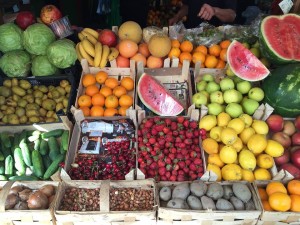 Photo: Ileana Johnson May 2015
Photo: Ileana Johnson May 2015
As liberals complain that people are going hungry and the first lady transforms the school lunch fare to “healthy” offerings nobody seems to like, the federal government is spending plenty on “domestic food assistance to provide food for the hungry and other vulnerable populations in this country.”
According to the Congressional Research Service, there are many agencies that offer food assistance to the needy in this country, citizens, non-citizens, and illegals.
The U.S. Department of Agriculture’s Food and Nutrition Service (USDA-FNS) offers many programs recently reauthorized by the 2014 farm bill called the Agricultural Act of 2014:
– Supplemental Nutrition Assistance Program (SNAP)
– Emergency Food Assistance Program (TEFAP)
– Commodity Supplemental Food Program (CSFP)
– Fresh Fruit and Vegetable Program
– Senior Farmers’ Market Nutrition program
USDA-FNS also provides programs that were not included in the farm bill:
– Special Supplemental Nutrition Program for Women, Infants, and Children (WIC)
– Child Nutrition Programs such as School Breakfast Program and National School Lunch Program (NSLP)
– Summer Food Service program (SFSP)
– Special Milk program
– Child and Adult Care Food Program (CACFP)
The U.S. Department of Health and Human Services’ Administration for Community Living (HHS-ACL) offers nutrition programs which are administered by the Administration on Aging (AOA) and authorized by the 1965 Older Americans Act (OAA):
– Congregate Nutrition Program
– Home Delivered Nutrition Program
– Grants to Native Americans such as Supportive and Nutrition Services
– Nutrition Services Incentive Program (NSIP)
Randy Alison Aussenberg and Kirsten J. Colello, the writers of the CRS report 42353 dated February 4, 2015, opine that “Some of these programs, such as the National School Lunch Program, have deep roots dating to the Depression era.” Since “hunger” is a concept that is difficult to measure, they say, the terms “food security” and “food insecurity” are used instead to “describe the ability to access adequate food.” How does one describe “adequate food” when the nation seems to be obese by some statistics and the incidence of Type II diabetes is on the rise?
Apparently, the terms “food security” and “food insecurity” can be “objectively measured” and refer to the “economic and access-related reasons associated with an individual’s ability to purchase or otherwise obtain enough to eat.” This is also interesting since people have varied genetic metabolic rates, nutritional needs, and appetites.
In 2006 a National Research Council panel looked at USDA’s measurements of food “adequacy” and concluded that “hunger is an individual-level physiological condition that is not feasible to measure through a household survey.” People cannot assess “gradations” of hunger, these are non-economic and individual behaviors. People miss meals due to illness, are too busy to eat, or not hungry. (Did we pay good money to come up with this conclusion?) As a result of the panel’s findings, USDA now measures “low food security” and “very low food security.” (National Research Council, Food Insecurity and Hunger in the United States: An Assessment of the Measure, Washington, D.C., 2006, pp. 23-51)
To be more “precise,” the U.S. Department of Agriculture’s Economic Research Service (USDA-ERS) asked if a household “was able to purchase or otherwise acquire enough to eat in 2013 (“food security”)” or unable to purchase or acquire enough to eat (“food insecurity”). Asking for someone’s opinion is a judgment call, it is not precise. The definition of “enough to eat” would vary widely.
ERS came up with four stages of food security. The parameters seem very subjective ways to “measure” objectively and precisely the need to eat which cannot be scientifically quantified.
– High food security (“no problems or anxiety about consistently accessing adequate food”)
– Marginal food security (“problems and anxiety at times about accessing adequate food but the quality, variety, and quantity of food intake were not substantially reduced”)
– Low food security (“reduced quality, variety, and desirability of their diets, but the quantity of food intake and normal eating patterns were not substantially disrupted”)
– Very low food security (“eating patterns of one or more household members were disrupted and food intake reduced because the household lacked money and other resources for food”)
The people found in the high and marginal food security levels are “food secure.” The people found in the low and very low food security levels are “food insecure.”
Considering U.S. households, 14.3 percent were “food insecure” in 2013, with 5.6 percent of those having “very low food security,” and 85.7 percent were “food secure.” Households with children were 19.5 percent “food insecure.” Households with senior citizens were 8.7 percent “food insecure.” Of the total surveyed, 62 percent had participated in the Supplemental Nutrition Assistance (SNAP), WIC, or National School Lunch programs. The rate of food insecurity rose from 11.1 percent in 2007 to 14.6 percent in 2008 and stayed in the range of 14.3-14.9 percent ever since. www.fas.org/sgp/misc/R42353.pdf
The 2010 Government Accountability Office (GAO) enumerated 70 domestic programs that pertain to food and nutrition. The CRS report discusses 17 food programs. Programs vary by target population (pregnant women, children, older adults), by eligibility requirements, and by types of help provided (commodity foods as opposed to prepared meals).
SNAP, formerly known as the food stamp program, varies from state to state. Many other programs are administered by state and local health departments. USDA “commodity foods” include “entitlement commodities” (recipients are entitled to them by law) distributed by TEFAP, CSFP, NSLP, SFSP, HHS-ACL, and CACFP. USDA also distributes “bonus commodities,” food purchases “based on requests from the agricultural producer community.” (See CRS Report RL34081)
In 1940, the first pilot Food Stamp Program, sold orange and blue food stamps to recipients. One dollar provided the recipient with $1 worth of any food and 50 cents worth of “blue stamps” which could only be used to buy surplus agricultural products. Commodity donations preceded the National School Lunch program. TEFAP receives USDA commodity foods and bonus commodities purchased by USDA from agricultural producers with surplus goods or in need of price supports. “Farm-to-schools” programs are currently promoted to convince cafeterias to buy from local and regional farms. (CRS R42353, p. 6)
With all these food and nutrition programs in place, why are American citizens falling through the cracks of hunger, nutrition, and need? Why is the nation as a whole deemed obese?
ILEANA JOHNSON
American By Choice
